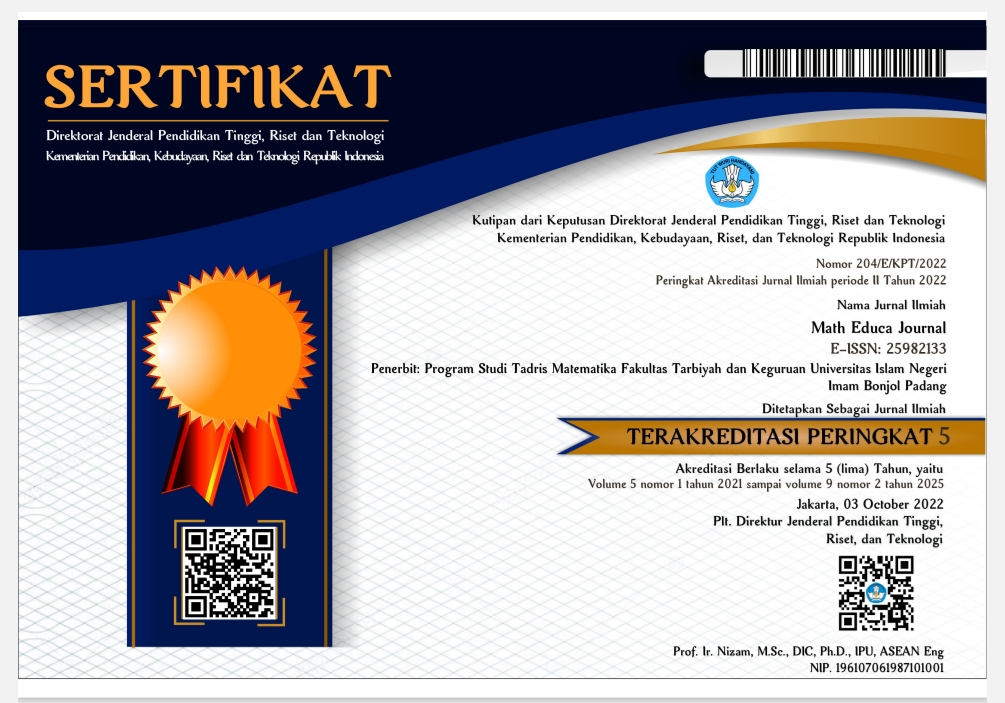KEEFEKTIFAN MODEL PEMBELAJARAN CPS (CREATIVE PROBLEM SOLVING) DENGAN MEDIA APLIKASI KAHOOT BERORIENTASI PADA KEMAMPUAN PEMECAHAN MASALAH SISWA KELAS VII MTs PESANTREN DARUL IHSAN SALOHE
Abstract
Keywords
Full Text:
PDFReferences
Ariani, Y., Helsa, Y., & Ahmad, S. (2020). Model Pembelajaran Inovatif untuk pembelajaran matematika di Kelas IV Sekolah Dasar (1st ed.). Deepublish.
Febriyanti, C., & Irawan, A. (2017). Meningkatkan Kemampuan Pemecahan Masalah dengan Pembelajaran Matematika Realistik. Delta-Pi: Jurnal Matematika Dan Pendidikan Matematika, 6(1), 31–41. http://ejournal.unkhair.ac.id/index.php/deltapi/article/view/350
Fitriani, F. (2020). KEMAMPUAN PEMECAHAN MASALAH SISWA SMP. JTMT : Journal Tadris Matematika, 1(1). https://doi.org/10.47435/jtm.v1i1.393
Hasmiati, H. (2013). Efektifitas Pembelajaran Matematika Realistik dengan Setting Kooperatif Tipe TEAM dan Tipe TGT Materi Volume Bangun Ruang Pada Kelas V SD inpres Bakung II. Universitas Negeri Makassar.
Herlawan, & Hadija. (2017). Peningkatan Kemampuan Pemecahan Masalah Matematis Siswa Kelas VII Melalui Penerapan Model Pembelajaran Creative Problem Solving (CPS) Berbasis Kontekstual. EDU-MAT: Jurnal Pendidikan Matematika, 3(1), 33–38.
Hidayah, S. N. (2016). Keefektifan Pembelajaran CPS Berbantuan Fun Card pada Pencapaian Kemampuan Pemecahan Masalah Siswa.
Mayasari, P., Halim, A., & Ilyas, S. (2013). Model Pembelajaran Creative Problem Solving Untuk Meningkatkan Penguasaan Konsep Dan Keterampilan Generik Sains Siswa SMP. Jurnal Pendidikan Sains Indonesia, 1(1), 58–67.
Muhammad, G. M., Septian, A., & Sofa, M. I. (2018). Penggunaan Model Pembelajaran Creative Problem Solving Untuk Meningkatkan Kemampuan Pemecahan Masalah Matematis Siswa. Mosharafa: Jurnal Pendidikan Matematika, 7(3), 28–30.
Mulyati, T. (2016). Kemampuan Pemecahan Masalah Matematis Siswa Sekolah Dasar (Mathematical Problem Solving Ability of Elementary School Students). EDUHUMANIORA: Jurnal Pendidikan Dasar, 3(2), 1–20.
Nurgiyantoro, B. (2010). Penilaian Pembelajaran Sastra Berbasis Kompetensi. BPFe.
Nurjannah, N. (2020). Proses Berpikir Kreatif Siswa Smp Berdasarkan Tahapan Wallas Dalam Memecahkan Masalah Matematika Ditinjau Dari Adversity Quotient (Aq). JTMT : Journal Tadris Matematika, 1(1), 7–13. https://doi.org/10.47435/jtm.v1i1.391
Payadnya, I. P. A. A., & Jayantika, I. G. A. N. T. (2018). Panduan Penelitian Eksperimen Beserta Analisis Statistik dengan SPSS. In Deepublish. Deepublish.
Purwati, R., Hobri, H., & Fatahillah, A. (2016). Analisis Kemampuan Berpikir Kritis Siswa dalam Menyelesaikan Masalah Persamaan Kuadrat pada Pembelajaran Model Creative Problem Solving. KADIKMA, 7(1). https://doi.org/https://doi.org/10.19184/kdma.v7i1.5471
Sari, A. D., & Noer, S. H. (2017). Kemampuan Pemecahan Masalah Matematis dengan Model Creative Problem Solving (CPS) dalam Pembelajaran Matematika. Prosiding Seminar Nasional Matematika Dan Pendidikan Matematika 2017.
Septian, A., Komala, E., & Komara, K. A. (2019). Pembelajaran dengan Model Creative Problem Solving (CPS) untuk Meningkatkan Kemampuan Berpikir Kreatif Matematis Siswa. Jurnal Prisma Universitas Suryakancana, 8(2), 182–190.
Suci, A. A. Wa., & Rosyidi, A. H. (2013). Kemampuan Pemecahan Masalah Matematika Siswa Pada Pembelajaran Problem Posing Berkelompok. MATHEdunesa, 1(2), 1–8.
Sugiyono. (2019). Metode Penelitian Kuantitati, Kualitatif dan R&D. Alfabeta.
Tryastuti, I. Y. (2014). Keefektifan Pembelajaran Cps Berbasis Hoa Terhadap Kemampuan Berpikir Kritis Peserta Didik Kelas Vii Materi Segiempat. https://lib.unnes.ac.id/23211/
Wardani, A., Mytra, P., & Fitriani, F. (2021). Profil Berpikir Reflektif dalam Memecahkan Masalah Sistem Persamaan Linear Dua Variabel Ditinjau Dari Kemampuan Awal. JTMT: Journal Tadris Matematika, 2(1), 1–8. https://doi.org/10.47435/jtmt.v2i1.641
Zahroh, H., Hafidah, H., Dhofir, D., & Zayyadi, M. (2020). Gerakan Literasi Matematika dalam Peningkatan Kemampuan Pemecahan Masalah Matematis Siswa. Sustainability (Switzerland), 9(2), 1–9. https://pesquisa.bvsalud.org/portal/resource/en/mdl-20203177951%0Ahttp://dx.doi.org/10.1038/s41562-020-0887-9%0Ahttp://dx.doi.org/10.1038/s41562-020-0884-z%0Ahttps://doi.org/10.1080/13669877.2020.1758193%0Ahttp://sersc.org/journals/index.php/IJAST/article
Refbacks
- There are currently no refbacks.

This work is licensed under a Creative Commons Attribution-NonCommercial-ShareAlike 4.0 International License.
The Journal Space of the Mathematics Education Department
Faculty of Education and Teacher Training
State Islamic University of Imam Bonjol Padang
Email: mej.uinibpadang@gmail.com

Math Educa Journal is licensed under a Lisensi Creative Commons Atribusi-NonKomersial 4.0 Internasional.
Based on a work at https://ejournal.uinib.ac.id/jurnal/index.php/matheduca.
All rights reserved p-ISSN: 2580-6726 | e-ISSN: 2598-2133




